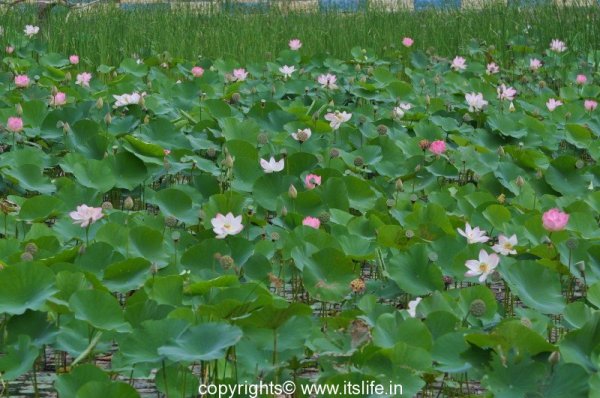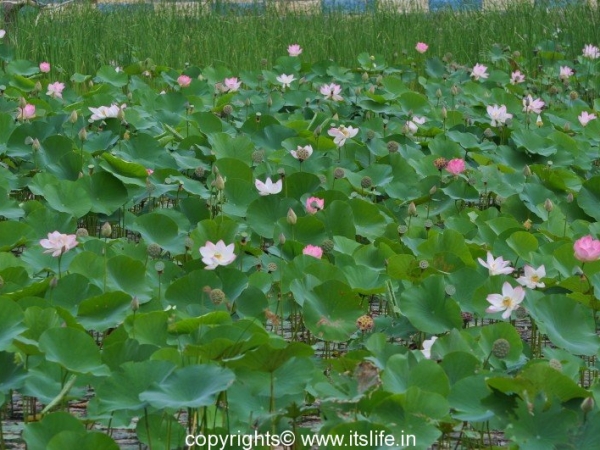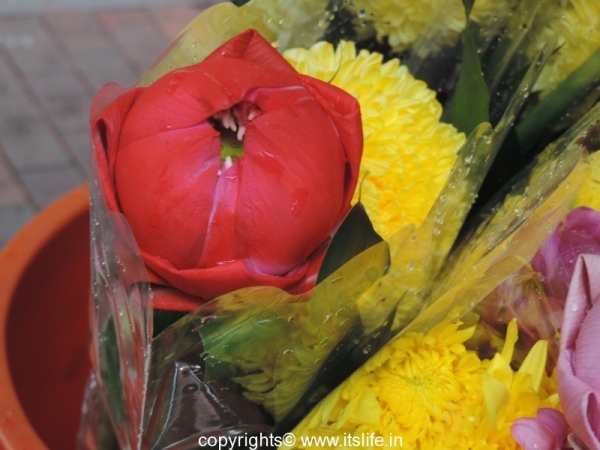Lotus flower since centuries has been a symbol of beauty, peace, purity, and non-attachment. The flower is widely depicted in Hinduism and Buddhism. Hence, this exotic flower is the national flower of India and Vietnam.
Picture – Lake on the way to Shivanasamudra
The botanical name is Nelumbo nucifera belonging to family Nelumbonaceae. Nelumbo nucifera bloom in pink, red, and white and is native to tropical Asia and Queensland, Australia.
Picture – Red Lotus near a Buddhist Temple in Singapore
Common names are Indian Lotus, Sacred Lotus, Bean of India, Padma, Kamal, Tavare, Shweta Karnika (White lotus), and so on.
Nelumbo lutea is the Yellow lotus native to North America. Common names are American Lotus, Yellow Lotus, and Water-chinquapin.
Lotus is an aquatic perennial, very popular in beatifying water gardens.
In India you can see large lakes filled with either white or pink lotus. Many painters and poets have been inspired by these exotic flowers.
Picture – White lotus lake near Bangalore
Lotus flowers bloom on thick stems that rise several feet above the water. The leaves are large, either oval or round in shape covered with miniscule hairs. The diameter of the leaves can be up to 2 feet. The flower can be as big as 10 to 12 inches wide in full bloom. Once the flower wilts, the triangular seed pod is exposed.
The seeds fall off into the water and get embedded in the lake bed to sprout into new lotus plants. The plant spreads to a large area in suitable conditions.
To commemorate the national flower, the Indian Postal Department has issued a stamp depicting the flower.
Picture – Lotus (left), Lily (right)
Center of the flower is very unique to this flower. The cup like structure is yellow when fresh containing seeds. This differentiates between a lotus and a lily. Also Lilies bloom in various hues, whereas Lotus blooms in pink, red, white, and yellow.
Picture – Seeds
The famous Bahai temple situated in New Delhi is designed like a Lotus. Parents name their new born with lotus names across the globe.
Propagation
The roots of Nelumbo nucifera are planted in the soil of the pond or river bottom, while the leaves float on top of the water surface.
Lotus in various cuisines
Lotus petals, stems, leaves, seeds, and roots are all used in various cuisines in Asia. The leaves are used to wrap food. The roots are pickled; the seeds are munched like nuts and popped like popcorn known as Phool Makhana. The stamens are dried and used to prepare tea in Vietnam.
Medicinal Uses
All the parts of the Lotus plant are used in traditional Asian herbal medicine. The roots especially are rich in dietary fiber, vitamin C, potassium, thiamin, riboflavin, vitamin B6, phosphorus, copper, and manganese.
Uses
Dried seed cup is regularly used in Ikebana / flower arrangements. A special robe known as Kya Thingahn is woven using Lotus plant fibers in Burma. This robe adorns the idols of Lord Buddha. The fiber is procured from Inle Lake situated in Shan Hills in Myanmar.
White or pink Lotus is offered to Lord Ganesha during the 21 Pushpa pooja, while chanting the following:
White Lotus: Om Vighan Rajaye Namah Schweta Karnika Pushpam Samarpayami
Pink Lotus: Om Vighan Rajaye Namah Padma Pushpam Samarpayami
Recipes using different parts of Lotus:
Lotus Stem Chips
Yakhni




